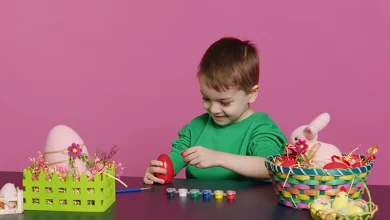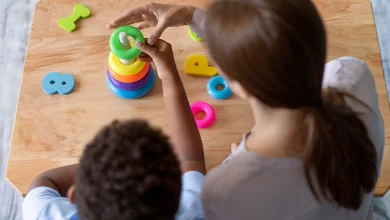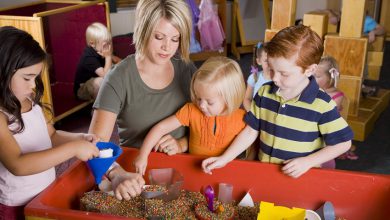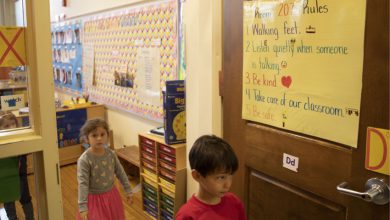5 Ways to Ensure High-Quality Literacy Instruction in Pre-K
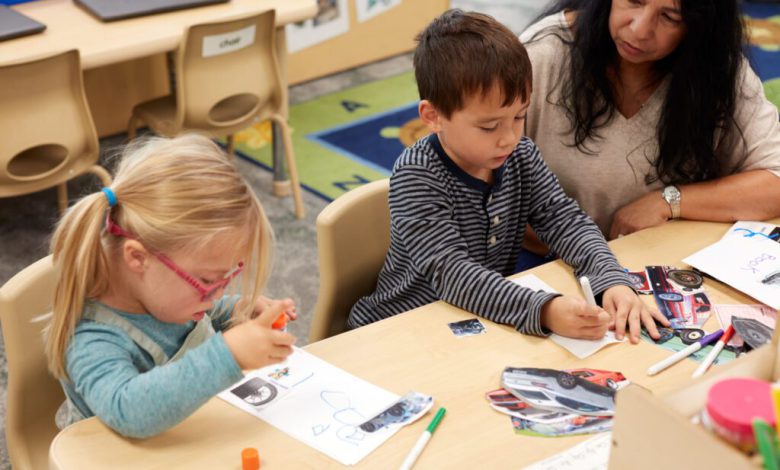
As I work with programs around the country, one of the most frequent questions I get from administrators, particularly those who are new to having pre-K programming in their school, is “How do I ensure pre-K literacy learning is happening in a play-based environment?”
Program leaders want to ensure that the instruction being provided aligns with the research from the science of reading and what that research tells us is most developmentally appropriate in the pre-K year. But how can we know that this is happening?
Here are five practices to look for when observing pre-K classrooms for high-quality early literacy instruction.
1. Engaging in Conversations
This one is as much a “listen for” as a “look for,” as this practice considers the essential role that conversations play in promoting children’s oral language development. Research tells us over and over again that oral language plays a critical role as the precursor of written language.
A classroom that intentionally promotes oral language development is alive with the busy hum of active learning. Listen for back-and-forth exchanges between children and children, teachers and children, and teachers and teachers, with both teachers and children asking and answering questions and describing their ideas, feelings, and work.
2. Connecting With Books and Stories
Look for evidence that teachers are leveraging the power of books and stories to promote children’s understandings of story structure and concepts of print and to help children build vocabulary, background knowledge, and comprehension strategies. Pre-K schedules should include multiple times of day for a variety of types of read-alouds. At the beginning of the pre-K year, these read-alouds may be shorter in duration to align with young children’s more limited ability to sustain attention. But as teachers offer rich, interactive read-alouds, they will see children’s capacity to stay engaged grow over this critical year of development.
Read-alouds should be among the most joyful experiences you witness during your visits to classrooms, and I encourage you to take in as many as you can. Maybe even lead a few! Meaningful read-alouds help children discover new ideas, travel to new places, meet and connect with new characters, and solve problems in new ways. Look for (and listen for) ways that children participate during read-alouds and look for how often they choose to pick up, enjoy, and talk about books that are in the classroom. Ask them about the books and stories they’ve enjoyed and watch their faces light up as they describe their early experiences with literature.
3. Promoting Functional Literacy
Functional literacy relates to everyday authentic reading and writing skills used to navigate daily life. Look for ways that teachers are promoting functional literacy through the intentional incorporation of meaningful environmental print. Note that authentic, hand-written materials are typically far more impactful than commercially prepared ones, especially when children have the opportunity to observe the teacher writing.
“What’s for snack today? Let’s check the Snack Menu!”
“What is the most exciting thing that happened today? Let’s write about it in our classroom journal! “
“We’re almost out of paper towels. Uh-oh, let’s leave a note for Ms. Baker saying that we need more so she can restock tonight.”
When teachers model and promote functional literacy, they help young children experience the heady feeling of competence. They help them know what it feels like to “be a reader” and to enjoy the personal independence that comes from literacy.
4. Proving Intentional Instruction in Language and Literacy
Children can and do pick up a great many skills through incidental exposure to them, but there will also always be a place for intentional, direct instruction. At this age, daily instruction should be provided to help children build skills related to phonemic awareness, early phonics and word recognition, and vocabulary. Short, focused activities that engage children in “playing with pre-reading” work best. This does not look like teacher-centered “sit and get” learning, but rather, what you observe should be prioritizing interactions—songs, chants, body movements, collaboration, and contributions from all children. Often, they occur during small-group instruction times so that teachers are better able to focus on individual children’s strengths and needs.
A primary goal of any literacy program should be to intentionally nurture a love of reading. Part of loving any skill is your ability to do it well. Direct instruction in language and literacy is not meant to replace a love of reading but rather foster it. So look for how teachers are helping children develop discrete skills and sharing with them how to use these skills in ways that children themselves find meaningful, such as by furthering their creative and imaginative play (e.g., referencing nonfiction books to help them build and create or writing letters, lists, signs, etc.).
5. Building Background Knowledge
In order to have things to think about, talk about, and write about, children need a wide variety of experiences that build their background knowledge, which is the key to comprehension. Talk to teachers about the learning experiences they are planning to intentionally build children’s background knowledge. Long-term studies of topics that children find interesting can engage them in complex thinking and problem solving while also building vocabulary.
An essential aspect of a high-quality pre-K curriculum, like The Creative Curriculum for Pre-K, is its dedication to guiding children’s pre-literacy learning in rich, interesting ways that are both developmentally appropriate and supported by the science of reading. Whether it’s time to select a comprehensive curriculum for your pre-K classrooms or time to observe teachers implementing the curriculum you currently use, these five essential literacy practices should be represented.
If you haven’t already done so, I encourage you to download the free eBook titled Five Everyday Practices to Promote Essential Skills on Language and Literacy. Not only does it describe how the science of reading best plays out in pre-K classrooms, but it also includes guidance for using the book as the basis for a professional learning community centered around this topic.


